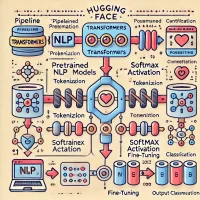Momentum Optimization in Machine Learning: A Detailed Mathematical Analysis and Practical Application Momentum optimization is a key enhancement to the gradient descent algorithm, widely used in machine learning for faster and more stable convergence. This guide will explore the mathematical underpinnings of gradient descent and momentum optimization, provide proofs of their convergence properties, and demonstrate how momentum can accelerate the optimization process through a practical example. 1. Gradient Descent: Mathematical Foundations and Proof of Convergence 1.1 Basic Gradient Descent Gradient Descent is an iterative algorithm used to minimize a cost function . It updates the parameters in the direction of the negative gradient of the cost function. The update rule for gradient descent is: Where: is the parameter vector at iteration . is the learning rate. is the gradient of the cost function with respect to . 1.2 Mathematical Proof Without Momentum Let’s consider a quadratic cost function, which is common in many machine learning problems: Where is a positive-definite matrix and is a vector. The gradient of this cost function is: Using the gradient descent update rule: Rearranging: For convergence, we require the eigenvalues of to be less than 1 in magnitude, which leads to the condition: is the largest eigenvalue of . This condition ensures that gradient descent converges to the global minimum. However, this convergence can be slow, especially when the condition number is large, leading to slow progress in directions corresponding to small eigenvalues. 1.3 Practical Example Without Momentum Let’s consider the specific quadratic function: Here, and . The gradient is simply , and the update rule becomes: For and initial value : This process shows a slow and steady convergence towards the minimum at , with each step reducing by a factor of 0.9. 2. Momentum Optimization: Mathematical Foundations and Proof of Convergence 2.1 Momentum-Based Gradient Descent Momentum improves upon gradient descent by introducing a velocity term that incorporates both the current gradient and the previous velocity. This leads to faster convergence and reduced oscillations. The update rules for momentum-based gradient descent are: Velocity Update:Where is the momentum coefficient. Parameter Update: 2.2 Mathematical Proof With Momentum Using the same quadratic cost function : Velocity Update: Parameter Update:Expanding the recursion:Simplifying: This equation reveals that momentum introduces a second-order term, effectively accelerating the optimization in directions where the gradient is consistent and damping oscillations in directions where the gradient changes rapidly. 2.3 Numerical Example With Momentum Let’s use the same quadratic function with , , and , : Iteration 1: Iteration 2: Iteration 3: Comparing this with standard gradient descent: Without Momentum: decreases steadily but slowly. With Momentum: decreases more rapidly due to the accumulated effect of past gradients, showing faster convergence. 3. Practical Application of Momentum in Machine Learning Momentum is widely used in training machine learning models, particularly in neural networks where the cost function may have flat regions and steep valleys. Below is a practical example of applying momentum to a simple linear regression problem: Explanation: Data Preparation: Synthetic data is generated for a simple linear regression task. Momentum-Based Gradient Descent: The function `gradient_descent_momentum` is used to optimize the model parameters. Comparison: The use of momentum accelerates the convergence, particularly when compared to standard gradient descent. This is because momentum smooths the updates and speeds up the optimization process in flat regions or areas with consistent gradient directions. Momentum optimization is a powerful enhancement to the gradient descent algorithm. The mathematical analysis demonstrates that momentum can significantly accelerate convergence by adding a velocity component that incorporates the history of gradients. This not only speeds up progress in directions of consistent gradients but also reduces oscillations, leading to smoother and more efficient optimization. The practical example below illustrates how momentum can be effectively applied in real-world machine learning tasks, offering faster and more stable convergence than standard gradient descent: Momentum Optimization: Practical Example and Visualization To better understand the impact of momentum on gradient descent, let’s explore a practical example with visualization. This example demonstrates how momentum affects the optimization path compared to standard gradient descent by visualizing the trajectory in a two-dimensional cost function space. Explanation: Cost Function: The function is chosen to create a narrow valley in the cost landscape. This setup helps illustrate the effect of momentum on the optimization trajectory, as the gradient in the direction is much smaller than in the direction. Gradient Descent Without Momentum: The red line in the plot represents the path taken by standard gradient descent. Since it follows the steepest descent at each step without considering the previous step, it takes a more direct but slower path to the minimum. This is evident in scenarios where the function has a narrow valley, as the optimizer moves slowly in the shallow direction. Gradient Descent With Momentum: The blue line in the plot shows the path taken by gradient descent with momentum. Momentum allows the optimizer to build speed in the…



